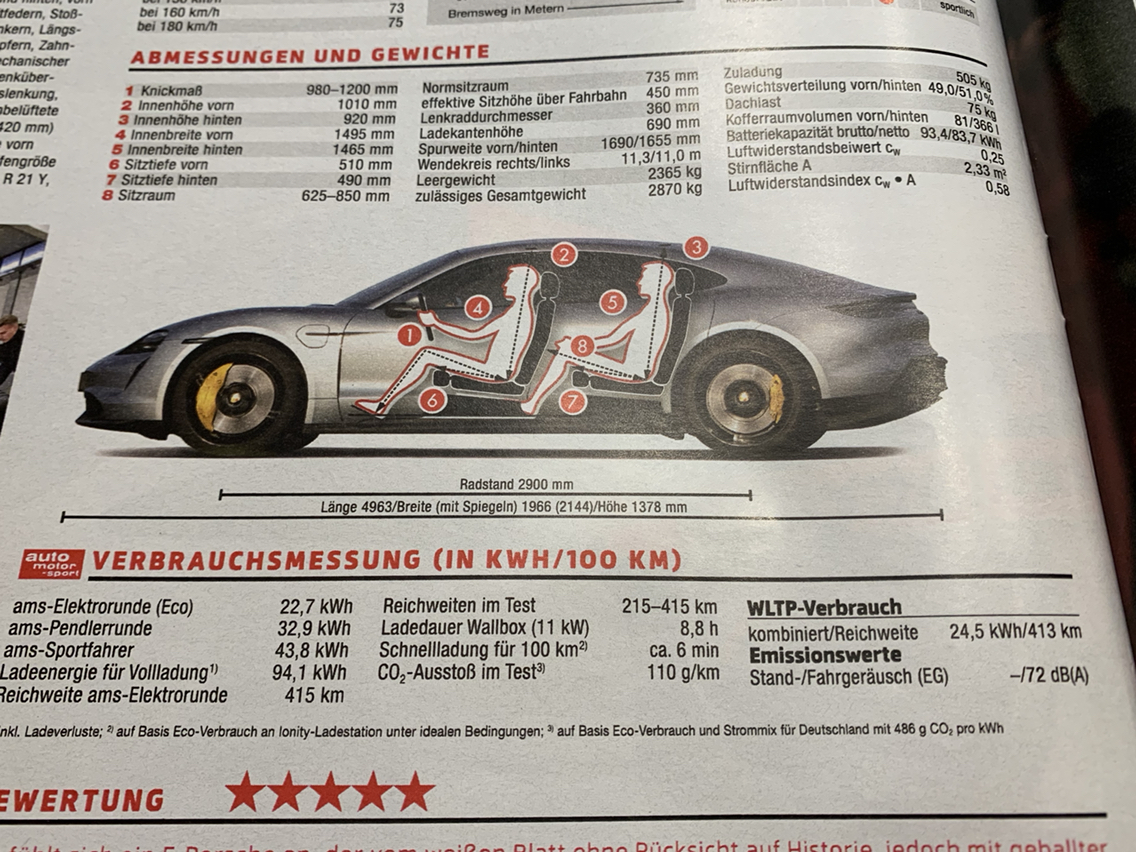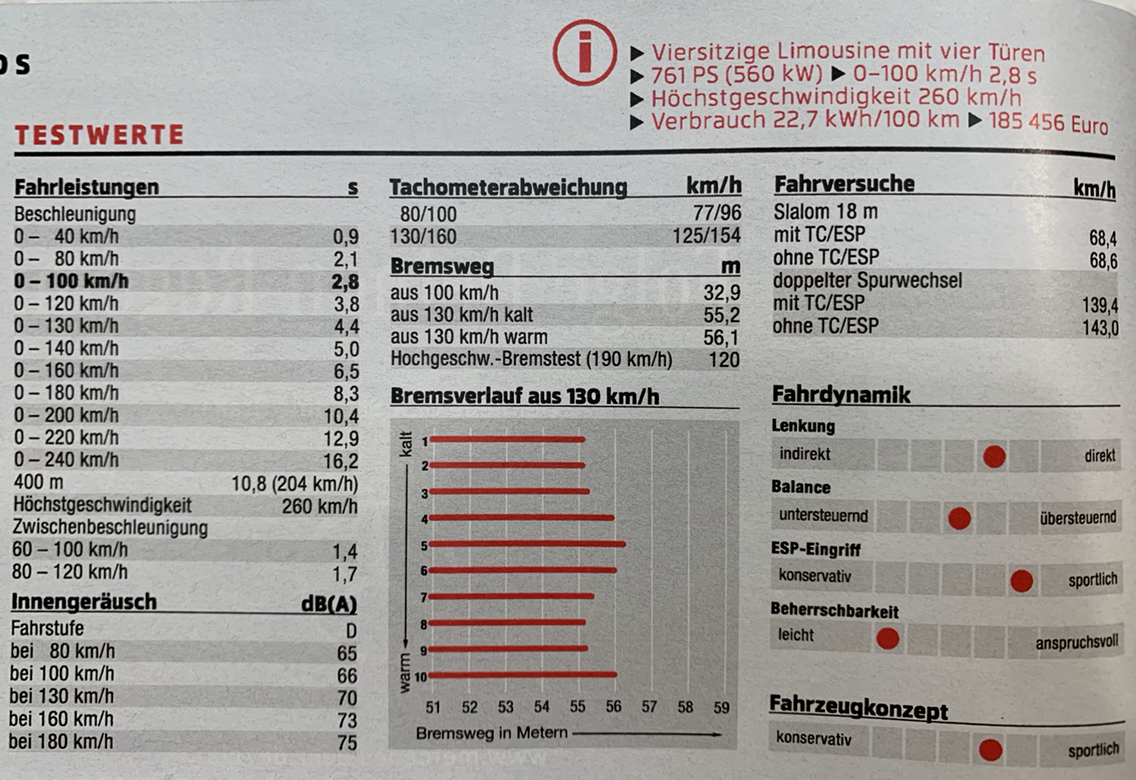Taycan Turbo - EPA rated 201 miles
#646
Cottage Industry Sponsor
Lifetime Rennlist
Member
Lifetime Rennlist
Member
Joined: Oct 2001
Posts: 25,784
Likes: 150
From: Silly Valley, CA
The very reputable German magazine Auto Motor und Sport has already put a Taycan Turbo S through a full test program. They measured all performance parameters, including power consumption and range.
They calculated that one can squeeze up to 415 km out of a full charge, which is about 259 miles. However, a commuter would see significantly less, and a "sports driver" would only see 215 km (134 miles):

Let's put the power draw in perspective. During the test program, the Taycan Turbo S consumed:
- 22.7 kWh/100km = 363 Wh/mile when driven in eco mode
- 32.9 kWh/100 km = 526 Wh/mile when used for commuting
- 43.8 kWh/100 km = 701 Wh/mile with a sports driver.
For comparison: My average over 18,000 miles with a Model S non-performance Dual drive is 329 Wh/mile. This is with Climate Control on all the time, and a brisk driving style.
Let me know, if you want to see any other data from the magazine's test results.
They calculated that one can squeeze up to 415 km out of a full charge, which is about 259 miles. However, a commuter would see significantly less, and a "sports driver" would only see 215 km (134 miles):

Let's put the power draw in perspective. During the test program, the Taycan Turbo S consumed:
- 22.7 kWh/100km = 363 Wh/mile when driven in eco mode
- 32.9 kWh/100 km = 526 Wh/mile when used for commuting
- 43.8 kWh/100 km = 701 Wh/mile with a sports driver.
For comparison: My average over 18,000 miles with a Model S non-performance Dual drive is 329 Wh/mile. This is with Climate Control on all the time, and a brisk driving style.
Let me know, if you want to see any other data from the magazine's test results.
The following 4 users liked this post by Nicole:
#647
RL Community Team
Rennlist Member
Rennlist Member
Joined: Jan 2013
Posts: 8,955
Likes: 2,639
From: The Woodlands, TX.
It's not just the weight. Period. Thanks for playing.

#648
The very reputable German magazine Auto Motor und Sport has already put a Taycan Turbo S through a full test program. They measured all performance parameters, including power consumption and range.
They calculated that one can squeeze up to 415 km out of a full charge, which is about 259 miles. However, a commuter would see significantly less, and a "sports driver" would only see 215 km (134 miles):
Attachment 1311269
Let's put the power draw in perspective. During the test program, the Taycan Turbo S consumed:
- 22.7 kWh/100km = 363 Wh/mile when driven in eco mode
- 32.9 kWh/100 km = 526 Wh/mile when used for commuting
- 43.8 kWh/100 km = 701 Wh/mile with a sports driver.
For comparison: My average over 18,000 miles with a Model S non-performance Dual drive is 329 Wh/mile. This is with Climate Control on all the time, and a brisk driving style.
Let me know, if you want to see any other data from the magazine's test results.
They calculated that one can squeeze up to 415 km out of a full charge, which is about 259 miles. However, a commuter would see significantly less, and a "sports driver" would only see 215 km (134 miles):
Attachment 1311269
Let's put the power draw in perspective. During the test program, the Taycan Turbo S consumed:
- 22.7 kWh/100km = 363 Wh/mile when driven in eco mode
- 32.9 kWh/100 km = 526 Wh/mile when used for commuting
- 43.8 kWh/100 km = 701 Wh/mile with a sports driver.
For comparison: My average over 18,000 miles with a Model S non-performance Dual drive is 329 Wh/mile. This is with Climate Control on all the time, and a brisk driving style.
Let me know, if you want to see any other data from the magazine's test results.
We'd like to see it. Duh.
 LOL
LOLThanks.
#650
#651
Cottage Industry Sponsor
Lifetime Rennlist
Member
Lifetime Rennlist
Member
Joined: Oct 2001
Posts: 25,784
Likes: 150
From: Silly Valley, CA
Originally Posted by CarMaven
The performance test data in detail (though it may have been mentioned elsewhere, I think)!!?
We'd like to see it. Duh. LOL
LOL
Thanks.
We'd like to see it. Duh.
 LOL
LOLThanks.

The following 5 users liked this post by Nicole:
AlexCeres (01-06-2020),
CarMaven (01-06-2020),
daveo4porsche (01-07-2020),
Der-Schwabe (01-08-2020),
MaxLTV (01-06-2020)
#652
#653
The very reputable German magazine Auto Motor und Sport has already put a Taycan Turbo S through a full test program. They measured all performance parameters, including power consumption and range.
They calculated that one can squeeze up to 415 km out of a full charge, which is about 259 miles. However, a commuter would see significantly less, and a "sports driver" would only see 215 km (134 miles):
Attachment 1311269
Let's put the power draw in perspective. During the test program, the Taycan Turbo S consumed:
- 22.7 kWh/100km = 363 Wh/mile when driven in eco mode
- 32.9 kWh/100 km = 526 Wh/mile when used for commuting
- 43.8 kWh/100 km = 701 Wh/mile with a sports driver.
For comparison: My average over 18,000 miles with a Model S non-performance Dual drive is 329 Wh/mile. This is with Climate Control on all the time, and a brisk driving style.
Let me know, if you want to see any other data from the magazine's test results.
They calculated that one can squeeze up to 415 km out of a full charge, which is about 259 miles. However, a commuter would see significantly less, and a "sports driver" would only see 215 km (134 miles):
Attachment 1311269
Let's put the power draw in perspective. During the test program, the Taycan Turbo S consumed:
- 22.7 kWh/100km = 363 Wh/mile when driven in eco mode
- 32.9 kWh/100 km = 526 Wh/mile when used for commuting
- 43.8 kWh/100 km = 701 Wh/mile with a sports driver.
For comparison: My average over 18,000 miles with a Model S non-performance Dual drive is 329 Wh/mile. This is with Climate Control on all the time, and a brisk driving style.
Let me know, if you want to see any other data from the magazine's test results.
These consumption numbers are based on the total energy coming from the wall connector. Includes the losses of the onboard charger and battery. That number is roughly 15% (varies from 12 to 18 over brands) higher than the car's consumption measured at the battery output (this latter is what's displayed on the instrument cluster).
Hard to judge these numbers as test conditions aren't shared. Elektrorunde has 30% highway section at 75mph. Avg speed for the rest is 32mph. That's all I figured out.
#654
Cottage Industry Sponsor
Lifetime Rennlist
Member
Lifetime Rennlist
Member
Joined: Oct 2001
Posts: 25,784
Likes: 150
From: Silly Valley, CA
Originally Posted by acoste
These consumption numbers are based on the total energy coming from the wall connector. Includes the losses of the onboard charger and battery. That number is roughly 15% (varies from 12 to 18 over brands) higher than the car's consumption measured at the battery output (this latter is what's displayed on the instrument cluster).
Hard to judge these numbers as test conditions aren't shared. Elektrorunde has 30% highway section at 75mph. Avg speed for the rest is 32mph. That's all I figured out.
Hard to judge these numbers as test conditions aren't shared. Elektrorunde has 30% highway section at 75mph. Avg speed for the rest is 32mph. That's all I figured out.
#655
Ladeenergie fur Volladung : 94,1kWh [Recharge energy]
Reichweite ams-Elektrorunde: 415km [range based on test cycle]
ams-Elektrorunde (Eco): 22.7kWh/100km [energy consumption under the test cycle]
22.7kWh/100km * 415km /100 = 94.2kWh
Taycan's total battery capacity is 93.4kWh, net capacity is 83.7kWh.
So the recharge energy is 83.7kWh plus charging losses = 94.1kWh in the AMS test. // disclaimer: it's not clear if AMS test includes discharging the bottom buffer as well
EPA hasn't shared exact numbers yet, but rough estimates showed 96 and 98kWh recharge energy.
Just an example: EPA used 94.249kWh energy to recharge the E-Tron which similarly has 83.7kWh net capacity: https://iaspub.epa.gov/otaqpub/displ...d=48427&flag=1
Reichweite ams-Elektrorunde: 415km [range based on test cycle]
ams-Elektrorunde (Eco): 22.7kWh/100km [energy consumption under the test cycle]
22.7kWh/100km * 415km /100 = 94.2kWh
Taycan's total battery capacity is 93.4kWh, net capacity is 83.7kWh.
So the recharge energy is 83.7kWh plus charging losses = 94.1kWh in the AMS test. // disclaimer: it's not clear if AMS test includes discharging the bottom buffer as well
EPA hasn't shared exact numbers yet, but rough estimates showed 96 and 98kWh recharge energy.
Just an example: EPA used 94.249kWh energy to recharge the E-Tron which similarly has 83.7kWh net capacity: https://iaspub.epa.gov/otaqpub/displ...d=48427&flag=1
The following users liked this post:
Bob Roberts (01-06-2020)
#656
Cottage Industry Sponsor
Lifetime Rennlist
Member
Lifetime Rennlist
Member
Joined: Oct 2001
Posts: 25,784
Likes: 150
From: Silly Valley, CA
Wow, good catch! They didn't apply the foot note (1) to the consumption data, so I thought it would be actual draw from the battery.
My value from the Tesla dual drive is actual consumption from the battery, I believe.
My value from the Tesla dual drive is actual consumption from the battery, I believe.
#657
In engineering perspective one pedal driving is the most normal and natural way to control output. Push to increase output and pull to decrease it. Every engineering product is designed this way.
#659
#660
Airplane and bicycle yes, but never driven a train. I'm not sure what you meant by your statement below, but being an engineer with a Masters and experience working in a number of industries including automotive, your statement "Every engineering product is designed this way" is simply incorrect. In fact, most machines that transport people are designed with a power supply (engine, motor, human leg), and a brake as a separate element.
In engineering perspective one pedal driving is the most normal and natural way to control output. Push to increase output and pull to decrease it. Every engineering product is designed this way.
In engineering perspective one pedal driving is the most normal and natural way to control output. Push to increase output and pull to decrease it. Every engineering product is designed this way.
Tesla employees have a habit of twisting facts to fit their arguments. Don't mind him.



